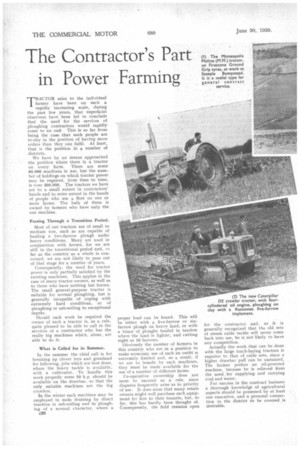The Contractor's Part in Power Farming
Page 68

Page 69

If you've noticed an error in this article please click here to report it so we can fix it.
TRACTOR sales to the individual I farmer have been on such a rapidly increasing scale, during the past few years, that superficial observers have been led to conclude that the need for the services of ploughing contractors would rapidly come to an end. This is so far from being the case that such people are to-day in the position of having more orders than they can fulfil. At least, that is the position in a number of districts.
We have by no means approached the position where there is a tractor on every farm. There are some 60,000 machines in use, but the number of holdings on which tractor power may be required, from time to time, is over 300,000_ The tractors we have are to a small extent in contractors' hands and to some extent in the hands of people who use a fleet on one or more farms. The bulk of them is owned by farmers who have only the one machine.
Passing Through a Transition Period.
Most of our tractors are of small to medium size, such as are capable of hauling a two-furrow plough under heavy conditions. Many are used in conjunction with horses, for we are still in the transitional period and, Fu far as the country as a whole is concerned, we are not likely to pass out of that stage for a number of years.
Consequently, the need for tractor power is only partially satisfied by the existing machines. This applies in the case of many tractor owners, as well as to those who have nothing but horses. The small general-purpose tractor is suitable for normal ploughing, but is generally incapable of coping with extremely hard conditions, or of ploughing or sub-soiling to exceptional depths.
Should such work be required the owner of such a tractor is, as a rule, quite pleased to be able to call in the services of a contractor who has the really big machines which, alone, are able to do it.
Whatis Called for in Summer.
In the summer the chief call is for breaking up clover leys and grassland for fallowing, jobs which are hest done, where the heavy tackle is available, with a cultivator. To handle this work properly some 50 h.p. should be available on the drawbar, so that the only suitable machines are the big crawlers.
In the winter such machines may he employed in mole draining by direct traction in sub-soiling and in ploughing of a normal character, where a c26 proper load can be found. This will be either with a five-furrow or sixfurrow plough on heavy land, or with a brace of ploughs hauled in tandem where the land is lighter, and cutting eight or 10 furrows.
Obviously the number of farmers in this country who are in a position to make economic use of such an outfit is extremely limited and, as a result, if we are to benefit by such machines, they must be made available for the use of a number of different farms.
Co-operative ownership does not seem to succeed as a rule, since disputes frequently arise as to priority of use. It does seem that many estate owners might well purchase such equipment for hire to their tenants, but, so far, this has hardly been thought of. consequently, the field remains open for the contractor and, as it is generally recognized that the old sets of steam cable tackle will never come back into use, he is not likely to have any competition.
Actually the work that can be done with the large track-laying tractors is superior to that of cable sets, since a higher drawbar pull can be sustained. The farmer prefers an oil-powered machine, because he is relieved from the need for supplying and carrying coal and water.
For success in the contract business a thorough knowledge of agricultural aspects should be possessed by at least one executive, and a personal connection in the district to be covered is desirable.
The type of land where contract services are usually most sought after is heavy clay, although a good deal is now being done elsewhere, especially where the jobs undertaken are of a more general nature. Good workmen, as in all businesses, can do much to 'lei', things along smoothly, and in this line they have a particular influence and may build up a personal goodwill.
The farmer's laboqr troubles are having a great influence on his outlook towards contract work, because he turns to anything that will assist him in rush times. Thus, apart from the heavy-duty tractor work mentioned above, there is a tendency to spread the work towards such operations as harrowing, drilling and harvesting on the ploughland. Iii grasshmd districts the cutting of the hay c7op has, for many years, been done under contract, and there are still large numbers who do the job with horses, on this basis. The tractor rnowc,r has, however, enabled this operation 1.0 be widely extended, and it may form a useful aspect of the work of contractors, who normally work on arable land, to fill in part of the time between spring cultivations and the corn harvest. In recent years, few contractors have been able to cope with the orders for mowing which have
been offered by neighbouring farmers.
Stimulated by the Government plan to subsidize, this year, the ploughingup and cleaning of worn-out grassland, the demand for contract services is likely to be well sustained for some time to come. Provided the business is run on efficient lines and proper charges made, there is no reason why the system should not ultimately occupy a leading place in British agriculture. There is general agreement as to the need for some such
scheme. D.N.Mcll_




































































































































